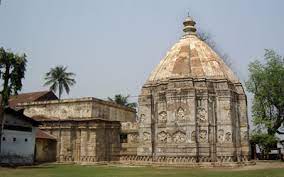Hayagriva Madhava Temple, Assam

Address
Hayagriva Madhava Temple, Hajo, Kamrup district, Guwahati, Assam 781102
Diety
Vishnu as Hayagriva
Introduction
Hayagriva Madhava Temple is situated on the Monikut hill. The hill is situated in Hajo of Kamrup District in Assam, India. Which is around 30 km to west of Guwahati. The Kalika Purana composed in the 11th century CE in Kamarupa talks about the origin of this form of Vishnu and his final establishment in the hill of Monikut, where the present temple is located.
Puranic Significance
According to Hindu mythology, in order to punish the demons, Madhu and Kaitava who had stolen the Vedas from Lord Brahma, Lord Vishnu was incarnated as Hayagriva. It is generally believed that the current structure of the temple was constructed by the king Raghudeva Narayan in the year 1583, though some historians are of the opinion that an emperor of the Pala dynasty had constructed it in the 6th century. For the Buddhists too, this is a sacred place as a number of Buddhist monks are of the opinion that this is the place where Buddha had attained Nirvana. The temple consists of three main parts –the shikhara, or the top, the center and the basement. The shikhara is pyramid-shaped. The base of the structure consists of huge brick pillars and there is a spacious entrance hall in the front. It is also believed that this structure was once destroyed by Kalapahar, and was later resurrected. A most striking feature of the temple is the continuous row of elephants carved on the lowest level of the temple walls – a structure akin to the stone cut temple of Ellora. The outer walls of the shrine are also covered with relief figures of the ten incarnations of Vishnu, devotees in procession and episodic scenes from the Ramayana and the Mahabharata. There is a big pond known as Madhab Pukhuri near the temple. Sayani, the first wife of Kalia Bhomora Borphukan donated a family of paiks and also a plot of land for their maintenance to the Hayagriva Madhava temple during the reign of Ahom king Kamaleswar Singha. The lamps in the sanctum sanctorum are never put off (akhanda deep) ever. Oil flows into the big earthen lamps through a simple tube connected to the oil tin.
Special Features
Doul, Bihu and Janmastami festivals are celebrated every year in the temple.
Century/Period/Age
11th century CE
Managed By
Archaeological Survey of India (ASI)- Assam
Nearest Bus Station
Hajo
Nearest Railway Station
Hajo, Guwahati.
Nearest Airport
Guwahati.






